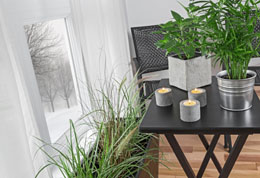With a little bit of planning and basic plant care skills, you can maintain a healthy indoor winter vegetable garden. Read this article to find out how.

Think of growing and maintaining a flower garden or a vegetable garden, and the first things that come to mind are land, fertile soil, light exposure, optimal temperature, water, etc. But, times are changing. If you are not lucky enough to have spare land or fertile soil, you still can grow plants in pots, or as a part of water gardening. And if the outdoors are very cold, which is not a favorable condition for plant growth, you can opt for indoor gardening.
With the arrival of winter, many gardening enthusiasts start getting concerned about the extremely cold weather and bitter environmental conditions since most of the garden vegetables and flowering plants cannot tolerate freezing temperatures. In such a case, nothing could be a better idea than starting an indoor garden. You may even grow culinary herbs right in the kitchen. Just keep these few essential tips in mind and you will be good to go.
Decide the Location
Since herbs and green vegetables require sunlight for ideal growth, the ideal location is the area that receives maximum filtered light. If possible, a spot near a south facing window (or an east facing window) is an excellent choice. Careful selection of an appropriate site is suggested for indoor plants, so that their growth is not compromised in any way.
Select Plant Varieties
Deciding which plants to grow in your indoor garden is one of the most challenging steps. This is because, not all vegetables are suited for warm and humid conditions of the indoors. Some herbs and vegetables that perform well in an indoor garden are pepper, tomato, bean, leaf lettuce, arugula, basil, ginger, etc. It is advised that you consult a horticulturist about the same and then start your project.
Prepare the Soil or Potting Mixture
In case you have a larger space, prepare a small bed which is raised at a particular height from the ground and lined with a plastic sheet. If you think this arrangement will be messy and difficult to maintain, proceed with container gardening. For both the options, you need to prepare a healthy soil mixture with adequate amounts of humus, sand, loam, peat moss, and farmyard compost. Adding humus forming soil components reduces the need for fertilizers.
Artificial Lighting System
Most of the leafy vegetables manage to grow even in less light. Nevertheless, fruits and veggies require artificial light for production of flower buds and fruiting bodies. You can consider the installation of a full spectrum lighting or daylight balanced lighting systems for your project. Also, check the plants periodically, and if required, relocate them to other areas.
Watering the Plants Adequately
The thumb rule is to keep a watch over the amount of water used for irrigation. Prolonged dry condition causes withering of the vegetables, and waterlogged soil will result in root-rotting. Irrigate the plants with room temperature water daily or on alternate days to keep the soil moist at all times.
Providing Plant Nutrients
When it comes to growing healthy vegetable indoors, using chemical fertilizers is not recommended. Instead, you can select organic nutrients or compost for such houseplants. A better option is to use aquarium water (just before changing) to irrigate them. For example, if you have grown tomatoes, add calcium-rich plant food and reduce the use of nitrogen fertilizers.
Other Plant Care Guidelines
Another factor that should be considered very seriously is maintaining an average temperature (preferably 16-26° F) around the houseplants. Also, indoor air circulation is a must to steer clear of any plant problems. You should have a keen eye to detect signs of disease and pest infestations in the initial stages. For disease-infested plants, isolate them and spray insecticidal soap on them after every few days.
It is a fun and rewarding hobby. Plan ahead, before the onset of winter and be ready with the required garden supplies. Follow these simple instructions and you will be surprised with the growth of healthy vegetables right in your indoor garden.






 Think of growing and maintaining a flower garden or a vegetable garden, and the first things that come to mind are land, fertile soil, light exposure, optimal temperature, water, etc. But, times are changing. If you are not lucky enough to have spare land or fertile soil, you still can grow plants in pots, or as a part of water gardening. And if the outdoors are very cold, which is not a favorable condition for plant growth, you can opt for indoor gardening.
Think of growing and maintaining a flower garden or a vegetable garden, and the first things that come to mind are land, fertile soil, light exposure, optimal temperature, water, etc. But, times are changing. If you are not lucky enough to have spare land or fertile soil, you still can grow plants in pots, or as a part of water gardening. And if the outdoors are very cold, which is not a favorable condition for plant growth, you can opt for indoor gardening.